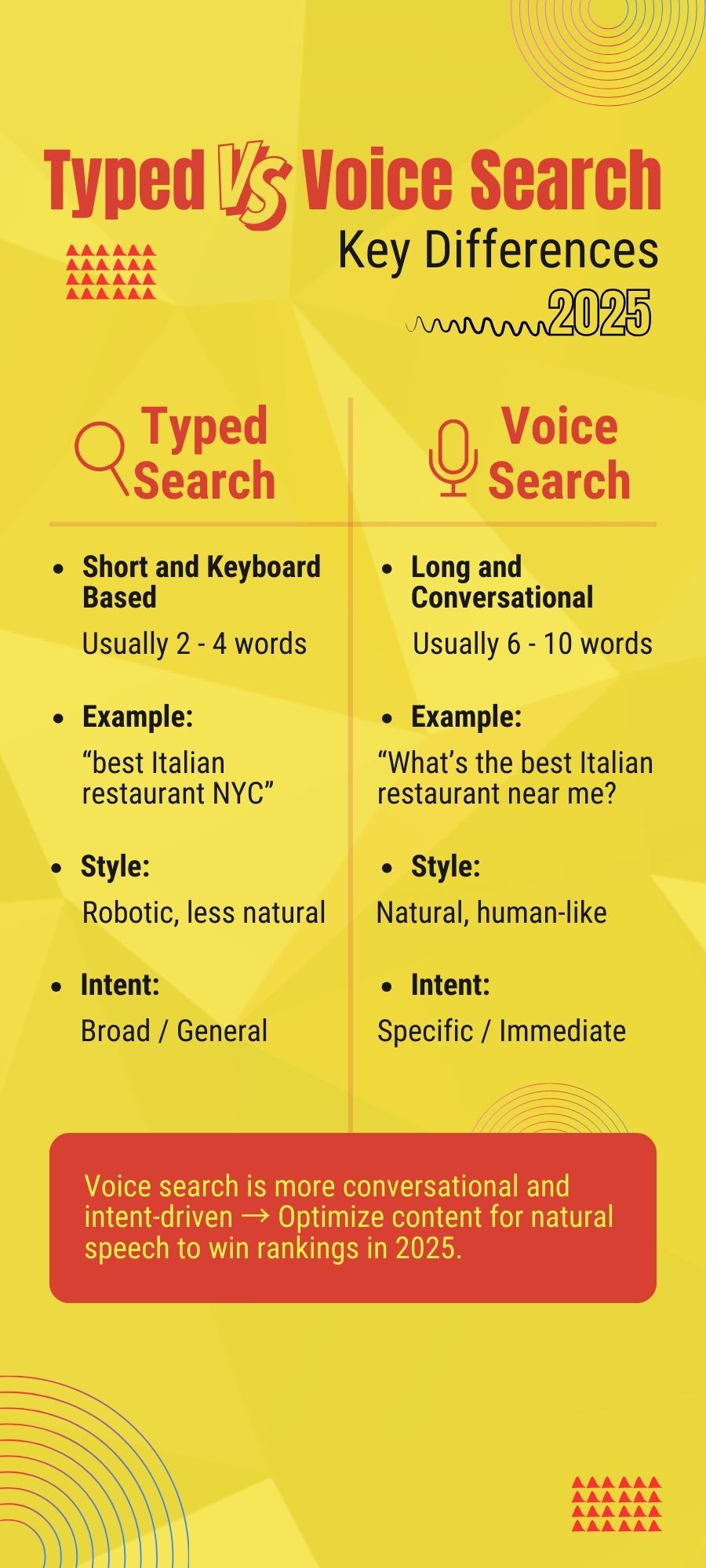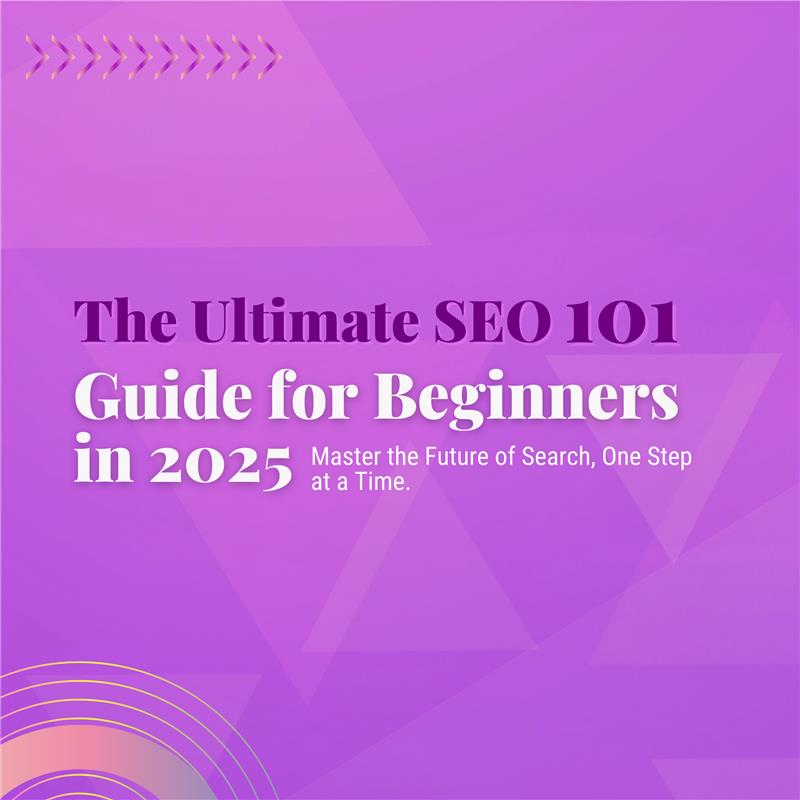In today’s fast-paced digital world, people no longer rely only on typing into search bars to find information. With the rise of smart assistants like Alexa, Siri, and Google Assistant, voice search has become an everyday part of our lives. Whether it’s asking for directions, finding the best restaurants nearby, or checking the weather, voice-driven queries are quickly dominating search behavior.
By 2025, experts predict that over half of all searches will be conducted using voice technology. To stay competitive, businesses should understand key strategies, including the Top 20 SEO Strategies and the SEO 101 Guide. This shift makes voice search SEO more important than ever for businesses and marketers who want to stay competitive.
If you’re a beginner looking to understand the basics or an SEO professional aiming to refine your strategy, this guide will walk you through everything you need to know about SEO for voice search—from fundamentals to advanced optimization techniques.

At its core, voice search is SEO is the process of optimizing your website and content in order for it to show up in the search results when someone asks questions vocally or verbally. In comparison with traditional SEO, based on keyword strings, voice search is based on natural, conversational forms of speech.
For example:
- Typed Search: “best Italian restaurant NYC”
- Voice Search: “What’s the best Italian restaurant near me right now?”
Optimizing for this new search pattern ensures that your content can be found by voice assistants like Google Assistant, Siri, Alexa, and Cortana.
Voice queries differ in several key ways:
- Length: Voice queries are longer, often 6–10 words, compared to short typed phrases.
- Tone: They use conversational language, mimicking natural speech.
- Intent: Voice searches often reflect immediate needs, such as directions, store hours, or product availability.
- Format: Many are framed as questions (Who, What, When, Where, Why, How).
Understanding these differences helps businesses tailor their voice search SEO optimization strategies to capture more traffic.

Voice search has quickly become a necessity and a natural way for users to engage with technology. By 2025, businesses that adapt to voice search SEO will have an advantage over their competition, while those that ignore it will likely disappear from online visibility.
- Widespread Use: Billions of devices—from smartphones to smart speakers—support voice search.
- Hands-Free Convenience: People can search while driving, cooking, or multitasking.
- Consumer Behavior: Users expect instant, accurate answers without scrolling through multiple links.
- SEO Trends: Google prioritizes mobile-first and voice-first indexing, making optimization critical.
In short, businesses that embrace voice search and SEO now will have a powerful edge in 2025 and beyond.
Voice search has quickly become a necessity and a natural way for users to engage with technology. By 2025, businesses that adapt to voice search SEO will have an advantage over their competition, while those that ignore it will likely disappear from online visibility.
Conversational and Long-Tail Queries
Unlike SEO in the past, when keywords were often short and broad, voice queries are generally long-tail and conversational. Instead of typing “weather Paris,” users are more likely to say, “What’s the weather in Paris this weekend?” This forces brands, through their digital content strategies, to think about natural language processing (NLP) and develop content that matches how humans actually speak.
Rise of Local SEO Through Voice Search
Local intent has a considerable emphasis on voice search. In fact, a considerable proportion of voice searches consist of “near me” phrases. Whether it’s for cafés, pharmacies, or gas stations, users are looking for immediate, location-based results. This means local SEO—Google Business Profile, local citations, and local reviews—matters more than ever with voice search.
Impact on Featured Snippets and Zero-Click Searches
Voice assistants typically read from featured snippets (position zero results). That means, instead of sending traffic to multiple websites, a single concise, optimized answer is selected. To win position zero, you need to provide a clear, structured answer in your content, with extra emphasis when writing in the Q&A format.
Mobile-First and Voice-First Indexing
Voice searches are predominantly on mobile, making Google’s mobile-first indexing fundamentally important. Things like speed, mobile responsiveness, and Core Web Vitals are very relevant to ranking for voice results. If your website isn’t optimized for mobile, you will be looking at missing out altogether in the voice-first world.
AI Assistants (Google, Siri, Alexa, Cortana) Role in Search
AI-driven assistants are changing how we operate search queries. Instead of having a list of results, assistants often deliver a single spoken answer. In order to obtain visibility, you should create structured content and target conversational keywords that are easily rendered by each assistant’s respective platform.
In 2025, being competitive means adjusting to the way people are using voice assistants. A business should optimize for conversational keywords, local intent, and mobile-first performance. Structured data, FAQs, and snippets all play a major role in visibility. Using all the above items will improve your chances of being the answer in voice results.
Optimize for Conversational Keywords
People do not use the same language that they type with. Voice queries are longer, more specific, and often asked in the form of a question. When targeting conversational, long-tail keywords, your content will be more in alignment with user intent and get you a better chance of ranking in results for SEO voice search.
Leverage Structured Data and Schema Markup
Structured data helps search engines understand the context of your content. Adding schema markup improves your visibility in featured snippets and voice answers. In 2025, this technique is essential to stand out in a crowded digital landscape.
Focus on Mobile Speed and Core Web Vitals
Almost all voice searches happen on mobile devices, so speed should be a top concern. If your mobile website doesn’t load in under 2.5 seconds, you’ll never compete with other retailers and brands. Strong performance on Core Web Vitals will drive more traffic, more money, and higher conversions.
Create FAQ Pages and Q&A Style Content
FAQ pages are ideal for voice search, as they are formatted in the question-answer format that assistants desire. Shorter, succinct responses improve the probability of your text being read aloud and may increase the chances of voice search optimization for your content. This means FAQ content is an important consideration when focusing on voice search SEO.
Target Featured Snippets (Position Zero)
Voice assistants frequently extract answers from featured snippets. To earn position zero, boil your answers down to summaries of 40–50 words. Good formatting, lists, and definitions can help you secure these features.
Use Local SEO Strategies for “Near Me” Searches
Voice search is very local, with many searches containing the phrase “near me.” If you have a Google Business Profile, make sure you have updated your profile. Be sure to update your reviews, hours, and location details, which will help you rank higher as a local voice search.
Enhancing performance for voice search does not always involve complex tools – it can actually begin with some simple measures. Writing in a conversational tone, using headings in question format, and keeping your content to the point are all useful mechanisms. Today’s local SEO is particularly helpful to elevate visibility in “near me” searches. Overall, these practical strategies make your website more voice search-friendly.
Write in a Conversational Tone
Avoid overly technical or robotic wording. Write the way people naturally speak. Content with a conversational tone resonates with users and aligns with the structure of voice queries.
Use Question-Based Headings
Most voice searches begin with words like “Who,” “What,” “How,” or “Where.” Structuring your headings this way increases visibility. It also makes your content more accessible to search engines and voice assistants.
Optimize Google Business Profile for Local Voice Searches
Consistency is key in local SEO. Keep your Name, Address, and Phone number (NAP) updated across all platforms. This increases trust and ensures your business shows up in voice search local SEO results.
Ensure Content Readability & Short Answers
Voice assistants prefer clear, simple language. Provide short answers within your content that can be easily read aloud. This makes your website more useful for quick voice-driven searches.
Keep Updating Content for Freshness & Relevance
Search engines reward fresh content, especially in fast-changing industries. Regularly updating your website improves ranking opportunities. Staying relevant also ensures better performance in voice results.
For seasoned SEO professionals, the focus goes beyond basics. AI-driven tools can uncover deeper insights into voice queries and user intent. Voice commerce is rising quickly, making optimization for transactional searches vital. Multilingual SEO and preparing for AI integration are key to dominating the future of voice search optimization.
Integrating AI Tools for Voice Query Insights
AI-powered SEO tools provide insights into how users phrase voice searches. These tools reveal patterns, question types, and intent signals. Leveraging AI helps refine strategies for greater precision in voice search SEO techniques.
Voice Commerce and Transactional Queries
The rise of v-commerce means more people buy through voice assistants. Optimizing for transactional queries like “Order pizza near me” or “Buy headphones online” drives sales. Businesses should adapt product pages to capture this demand.
Multilingual Voice Search Optimization
Global users search in different languages and dialects. Optimizing content for multilingual queries expands reach. This strategy is especially important for international brands in 2025.
Preparing for Future AI + Voice Search Integration
AI and voice technology are merging rapidly. Future search will deliver highly personalized results. Businesses preparing today for AI-driven voice search SEO will secure long-term success.
Voice search is no longer a trend of the future; it is here now, and by 2025, it will be most people’s method of discovering and finding information. Those businesses that can incorporate conversational content, quick-load mobile pages, and local SEO will win. Leaders will use additional innovations like AI-generated insights and multilingual optimization. The matter of fact is, time is now—optimize to be future-ready by preparing for voice search and voice search SEO.
Voice search is no longer a trend of the future; it is here now, and by 2025, it will be most people’s method of discovering and finding information. Those businesses that can incorporate conversational content, quick-load mobile pages, and local SEO will win. Leaders will use additional innovations like AI-generated insights and multilingual optimization. The matter of fact is, time is now—optimize to be future-ready by preparing for voice search and voice search SEO.
How to do voice search SEO?
To optimize for voice search, focus on conversational keywords that reflect how people naturally ask questions. Add structured data to make your content easier for search engines to understand. Creating FAQ pages with short, clear answers also boosts visibility. Pair this with mobile optimization and strong local SEO for the best results.

What does voice search mean for SEO?
Voice search changes SEO by shifting the focus from short keywords to natural language queries. Instead of typing, users speak in complete sentences or questions. This means businesses must adapt their content to match conversational patterns. It also emphasizes local results, mobile-first indexing, and featured snippets.

What is voice search SEO?
Voice search SEO is the process of optimizing websites to appear in search results when users ask questions through smart assistants. It involves targeting natural language, long-tail keywords, and FAQs. Unlike traditional SEO, it requires content to be concise, mobile-friendly, and structured for fast, accurate responses.

How is voice search changing the SEO landscape?
Voice search is reshaping how content is ranked and delivered. Instead of lists of links, assistants often provide a single spoken answer. This raises the importance of featured snippets, local SEO, and conversational content. Businesses that adapt to this change gain a strong competitive edge in visibility.

How to improve voice search SEO?
Improving voice search SEO starts with writing in a conversational tone and structuring content around user questions. Regularly update your site to stay fresh and relevant. Make sure your website is mobile-friendly, loads quickly, and uses schema markup. Optimizing local listings also boosts results for “near me” queries.


I am Wajiha Ghazal, Co-Founder of Concept Beans Pvt Ltd and AI Digital Marketing Expert and With a focus on AI-powered tools, strategies, and automation, I help businesses scale and thrive online. My expertise spans AI-driven SEO, paid advertising, content marketing, and data-led growth hacking. Passionate about the future of digital marketing, I actively share insights through global platforms and training sessions.


